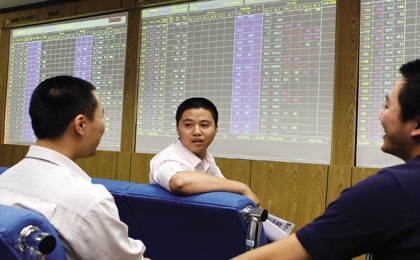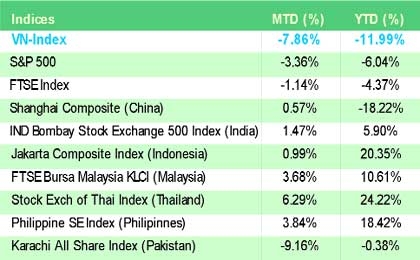Market at mercy of twin drivers forces
 |
| Many investors are sitting on the fence waiting to see which way the wind blows |
A combination of few ‘new’ cash inflows and a trend to ‘cash out’ of existing cash flows to buy back at lower prices caused a deep market recession in August.
The market needs to get more stable in the 430-440 point range before any clearer outlook. Once the cash flows (including ‘old’ and ‘new’) are outside the market awaiting for opportunities, factors to strongly signal the ‘floor’ of indices will determine any sustainable recovery. In our view, there are two important drivers for September.
The first is the market to drop to a level where stocks become more attractive compared to other investment choices such as bank deposits or real estate. Companies that are traded below 5.0x 2010 P/E are strong candidates for this criterion.
The second driver is macroeconomic policy adjustments that directly impact on credit growth, interest rates or control the supplies of stocks. We, however, only expect to see actual moves rather than announcements since confidence of investors has eroded after months of delays.
Different from July or August, September is the last bet for third quarter gross domestic product (GDP) growth if the government wants to meet its target. If no action is taken, it is less likely that the third quarter will have a higher rate than that of the second quarter.
In general, although the market is still highly sensitive, we expect to see both the ‘floor’ and quick recoveries no later than end of September. The market in September is likely to be affected by the following factors:
No breakthrough in macroeconomic policies
The market in August fell when macroeconomic conditions got worse.
The Vietnamese dong was further devalued by 2.1 per cent. In the long-run, the exchange rate adjustment will support Vietnam’s trade balance as a net importer. However, in the eyes of foreign investors, this is a meaningful risk where an investment lost value not only due to the drop in indices, but also because of foreign exchange issues.
When investors expect further devaluations in the future, it will hinder new foreigners’ cash flows into the market. The lack of supported liquidity is not good news for the market environment.
Inflation has also shown signs of bounce-back after three consecutive months of low numbers. The dong’s devaluation also implies the price adjustments on imported goods, so we might see a higher inflation in September compared to 0.23 per cent in August. The good news is that the slowdown of the global economy has lessened a lot of pressure on our domestic economy.
GDP growth in the third quarter might not meet expectations and even not exceed the second quarter’s outcome since there has been no further credit growth, while the restructuring of Vinashin and other state-owned corporations could have negative impacts. The consequence is that the third quarter’s financial statements might contain no surprise and some companies could experience negative growth compared to 2009.
We do not foresee a big chance for any jump in macroeconomic policies in September that could excite the stock market. However, if the government takes strong action, the floor will be hit much sooner, in a smaller scale before confidence is regained.
Unstable global economic environment
The global economy is currently neither pessimistic nor optimistic enough to maintain direct impacts on the VN-Index as what occurred in May and June. Global indices have probably experienced the worst period in 2010. However, the outlook is not bright enough to expect a surprising recovery for the remaining of the year when major economies such as the United States, the European Union or Japan have revised growth forecasts.
The Dow Jones Index fluctuated between 10,000 and 10,500 points during most of August due to the lack of supportive news. We also exclude the ‘double dip’ views since the futures indices are still positive and have shown no sign of deterioration. When the local and global economy is affected by different underlying factors, the correlations will drop significantly and major indices will lose most of reference value.
 |
| VN-Index versus other regional indices |
Vietnamese market underperforming its peers
Since the beginning of 2010 to the end of August, the VN-Index lost around 10 per cent, one of the highest in the region. Including the underperformance in 2009, Vietnam’s stock market seems to have fallen behind its underlying economy.
Currently, approximately 10 per cent of the listed stocks are trading at 5.0x 2010 P/E or below at the 430 VN-Index, many of which are fundamentally strong, growing at over 20 per cent, per annum.
If the market continues to fall, investments in shares will potentially become more attractive than bank deposits or real estate. Stocks with market value of 1.0x-2.0x face value and paying good dividends and are other options for value investors. Investors could refer to the list of stocks summarised by a number of criteria in the appendix when deciding to re-enter the market.
Cash flows have been restructured in substance
By the end of June and July, investors expected new cash flows to support the market swing after a long period of contradictory monetary policy. However, after over two months with no further serious action from the State Bank, everything is within the scope of expectations.
The fact that indices continuously broke through key supporting levels during August illustrated the disappointment of investors when new cash flows are still nowhere to be found. On the other hand, we see positive impacts from such substantial market corrections.
After strong selling pressure from securities firms on leveraged portfolios, the cash flow structure in the market has become much safer, ensuring more sustainable growth once the market bounces back with lower leverage.
‘Old/existing’ cash flows have been withdrawn out of the listed market to wait for more attractive investment opportunities. One of the key reasons for the sale-out for cash holdings is the expectation of further market corrections.
If the indices show clear signs of ‘flooring’, those ‘old’ cash flows together with a portion of ‘new’ cash flows will get back to the market very quickly. Deep market drops always go together with huge potential returns.
Hence, cash flows in September will benefit from the changes in quality and structure. When there is no signal from ‘new’ cash flows, the ‘old’ ones are important and a much easier source of funds to support the market when the floor gets closer.
Besides, we also observed a large amount of cash flows from non-bank institutions such as insurance companies and local funds still searching for opportunities. When the market recovers, the financial leverage services from securities firms are the familiar options to expand the cash availability in the stock market.
The supply of stocks is slowing
In line with the stagnant market, the supply of new shares is slowing down for a number of reasons.
Companies announcing plans to buy back shares when the shares are believed to be undervalued is one reason.
Some even announced to buy back up to 5 per cent of the charter capital. The buy-back decisions not only imply management’s confidence in the firm’s outlook, but also narrowing the supplies of shares, expanding the demand for listed stocks in the market.
Many companies have also deferred their listed plans due to the poor performance of the market. Overall, listing when the VN-Index is below 500 points is not an optimal choice if the enterprises have funding pressures. If the market does not recover strongly, new share issuances will suffer in September.
The second factor that could change investors’ psychology is the potential adjustments in relevant laws that could influence the market directly or indirectly.
Reviewing Article 13 and Decision 141, by the end of August, there is no confirmation on the likely delays of these pieces of law. However, detailed instructions have not been issued. We do not expect any material changes since this is a necessary step for the long-term development of the banking sector when the market grows bigger.
However, the State Bank may re-consider some of the ‘sensitive’ implementation guidelines to avoid too sudden impacts on the market. If that happens, the market will perceive positively.
By the end of July, US dollar credit growth had slowed compared to the average of H1-2010 when the exchange rate was adjusted. In order to at least maintain the same credit growth in the H2-2010, the State Bank will have to rely more on the dong.
After rumours of a drop in the base cash rate cooled, the remaining tools are the amendments in the open market operations and a part of the guidelines in Article 13 and Decision 141 to allow more room for loans. Though the State Bank is still very quiet to date, we believe that the opportunities equally share among the remaining four months of 2010.
What the stars mean:
★ Poor ★ ★ Promising ★★★ Good ★★★★ Very good ★★★★★ Exceptional
 Tag:
Tag:
Related Contents
Latest News
More News
- Tax sector wraps up 2025 and sets priorities for next year (December 25, 2025 | 14:00)
- A tipping point for digital and hybrid wealth management in Vietnam (December 23, 2025 | 13:33)
- $250 million deal targets women-owned SMEs, sustainable agriculture (December 22, 2025 | 17:40)
- Stock market posts resilient 2025 performance (December 19, 2025 | 18:17)
- Citi Vietnam receives 2025 AmCham CSR recognition (December 19, 2025 | 16:35)
- As global green supply chain reshapes, will Vietnam be left behind? (December 19, 2025 | 08:00)
- Banks gear up for massive capital increases (December 18, 2025 | 17:04)
- Securing capital and efficiency for Vietnam’s 2026-2030 growth ambitions (December 17, 2025 | 10:00)
- Energy sector in need of blended finance mechanisms (December 17, 2025 | 09:00)
- Vietnam still has room to mobilise capital for sustainable growth (December 17, 2025 | 08:57)























 Mobile Version
Mobile Version